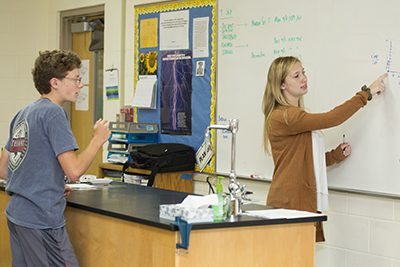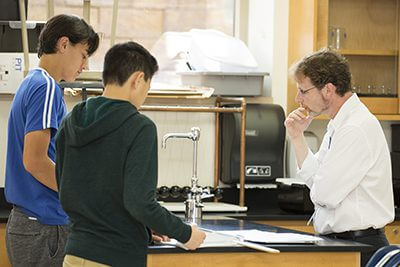January 4, 2018
 by Dr. Bill Hudson, Head of School
by Dr. Bill Hudson, Head of School
Just before break, the Washington Post reported that seven words were being banned from official documents being prepared for the 2018 budget at the Centers for Disease Control including “evidence-based” and “science-based.” The national conversation around “fake news” and questions about the veracity of climate change have placed science and science education at center stage. In addition, the steady drumbeat calling for more STEM education has ignited a passionate discourse about science education, particularly within a liberal arts education. In the midst of this often-polarizing discussion, I have repeatedly seen evidence that MPA does science ‘right’ by focusing on applied learning, critical thinking, and a grounding in fostering students to become citizen scientists.
The MPA science curriculum is founded on the principles of active and inquiry-based learning as first developed when the school was in its infancy. Our phenomenal science teachers continue to provide rich, thoughtful, experiences and opportunities for experimental design, while at the same time giving students the background and content they need to succeed in college and beyond. MPA students are encouraged to think critically about science by using their successes and failures in the lab as learning opportunities. What worked? What didn’t? How could it have been improved? Did it prove anything? These questions are best answered through learning by doing.
As an educator and a Mounds Park Academy parent, I fully embrace the approach to science at MPA that has as its goal to foster citizen scientists, a term used passionately by all of our science teachers, particularly Mr. Thomsen. A citizen scientist is a creative, inquisitive, questioning person who is fully aware of the world and embraces their responsibility for it. Students learn the habits and skills used by scientists and engineers: to ask questions, form hypotheses, design experiments, collect data, analyze the data, and then reflect on the meaning of those discoveries and how that may impact the world around them. Our new Makerspace enhances and builds upon our school’s tradition and whole-child education.

One of my first decisions after having been named head of school was to institute a rigorous curriculum review process that spans divisions and grades. The curriculum review process was designed to foster a continuous improvement model, and as such, runs on a four-year cycle that includes a review of existing curriculum, state and national standards, current research, and trends in curriculum, instruction, and assessment. After a year-long review, we found that our science curriculum aligns well with national and professional standards, is rigorous and challenging, and meets or goes beyond standards in place at local, state, and peer schools.
The science department also analyzed the results from the ACT Aspire tests in Middle School as well as the results from the PSAT, ACT, and alumni surveys. For instance, the results of the 2016 ACT Aspire test indicate that our average score is in the 80th percentile nationwide. Looking at the science scores of the ACT, MPA students are slightly above the national median benchmark among independent schools.
As a school committed to continuous improvement, the science curriculum at MPA continues to evolve. Enhancements emerged from the curriculum review process, such as the addition of AP Biology and the Graduate Certificate of Distinction in STEM. Others are on the horizon. For example, under discussion is an elective course focused on providing seniors with the opportunity to conduct independent, sustained scientific research.
The challenge that lies ahead for both MPA students and for our society at large is to balance STEM with the humanities. Both are necessary but not at the expense of either. Science, technology, and math are fundamental aspects of a 21st century education, but combined with a broad-based liberal arts education provide students an advantage in fostering critical thinking, communication, and creativity. Innovation and entrepreneurialism require both STEM and the humanities. The citizen scientists fostered by MPA are able to connect their deep content knowledge to the world in ways that prepare them to impact it positively.
As we begin a new year, I stand together with my colleagues with gratitude for the opportunity to walk alongside your brilliant and amazing children as their teachers, educators, coaches, role-models, and mentors. May the new year be filled with bright possibilities for all of us to dream big and do right together.